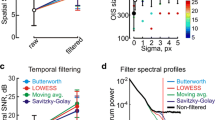Abstract
Eight mongrel white male rats were studied under urethane anesthesia, and neuron activity evoked by mechanical and/or electrical stimulation of the contralateral whiskers was recorded in the primary somatosensory cortex. Recordings were made using a digital USB chamber attached to the printer port of a Pentium 200MMX computer running standard programs. Optical images were obtained in the barrel-field zone using a differential signal, i.e., the difference signal for cortex images in control and experimental animals. The results obtained here showed that subtraction of averaged sequences of frames yielded images consisting of spots reflecting the probable position of activated groups of neurons. The most effective stimulation consisted of natural low-frequency stimulation of the whiskers. The method can be used for preliminary mapping of cortical zones, as it provides for rapid and reproducible testing of the activity of neuron ensembles over large areas of the cortex.
Similar content being viewed by others
REFERENCES
A. B. Vol'nova, T. V. Golikova, A. Yu. Ignashchenkova, and D. N. Lenkov, Long-term changes in the latent periods of afferent and efferent responses of neurons in the vibrissal motor cortex after unilateral section of the infraorbital nerve in neonates," Zh. Évolyuts. Biokhim. Fiziol. (in press).
L. B. Cohen, “Changes in neuron structure during action potential propagation and synaptic transmission,” Physiol. Rev., 53, 373–418 (1973).
J. L. Dowling, M. M. Henegar, D. Liu, C. M. Rovainen, and T. A. Woolsey, “Rapid optical imaging of whisker responses in the rat barrel cortex,” J. Neurosci. Meth., 66, No. 2, 113–122 (1996).
R. D. Frostig, E. E. Lieke, D. Y. Ts'o, and A. Grinvald, “Cortical functional architecture and local coupling between neuronal activity and the microcirculation revealed by in vivo high-resolution optical imaging of intrinsic signals,” Proc. Natl. Acad. Sci. USA, 87, 6082–6086 (1990).
A. Grinvald, E. Lieke, R. D. Frostig, C. D. Gilbert, and T. N. Wiesel, “Functional architecture of cortex revealed by optical imaging of intrinsic signal,” Nature, 324, 361–364 (1986).
M. M. Haglund, D. W. Hochman, J. R. Meno, A. G. Ngai, and H. R. Winn, “Mechanisms underlying the intrinsic signal during optical imaging of rat somatosensory cortex,” Soc. Neurosci. Abstr., 20, 1264 (1994).
M. M. Haglund, G. A. Ojemann, and D. W. Hochman, “Optical imaging of epileptiform and functional activity in human cerebral cortex,” Nature, 358, 668–671 (1992).
D. N. Lenkov, A. B. Vol'nova, and T. V. Golikov, “The physiological characteristics of neurons of the rat's primary motor cortex after neonatal vibrissae sensory deprivation,” in: Proceedings of the 12th Meeting of the International Society for Developmental Neuroscience, Canada (1998).
S. A. Masino, M. Kwon, Y. Dory, and R. D. Frostig, “Characterization of functional organization within rat barrel cortex using intrinsic optical imaging through a thinned skull,” Proc. Natl. Acad. Sci. USA, 90, 9998–10002 (1993).
S. A. Masino and R. D. Frostig, “Quantitative long-term imaging of the functional representation of a whisker in rat barrel cortex,” Proc. Natl. Acad. Sci. USA, 93, 4942–4947 (1996).
B. A. McVicar, T. W. Watson, F. E. LeBlanc, S. G. Borg, and P. Federico, “Mapping of neural activity patterns using intrinsic optical signals: from isolated brain preparations to the intact human brain,” in: Optical Imaging of Brain Functions and Metabolism, Plenum Press (1993), pp. 71–79.
S. M. Narayan, E. M. Santori, A. J. Blood, L. Sikkens, and A. W. Toga, “Functional increases in blood volume over somatosensory cortex,” J. Cereb. Blood Flow Metab., 15, 754–765 (1995).
B. E. Peterson and D. Goldreich, “A new approach to optical imaging applied to a rat barrel cortex,” J. Neurosci. Meth., 54, 39–47 (1994).
B. E. Peterson, D. Goldreich, and M. M. Merzenich, “Optical imaging and electrophysiology of rat barrel cortex. I. Responses to small single-vibrissa deflections,” Cerebral Cortex, 8, No. 2, 173–183 (1998).
B. R. Sheth, C. I. Moore, and M. Sur, “Temporal modulation of spatial borders in rat barrel cortex,” J. Neurophysiol., 79, No. 1, 464–470 (1998).
Author information
Authors and Affiliations
Rights and permissions
About this article
Cite this article
Inyushin, M.Y., Vol'nova, A.B. & Lenkov, D.N. Use of a Simplified Method of Optical Recording to Identify Foci of Maximal Neuron Activity in the Somatosensory Cortex of White Rats. Neurosci Behav Physiol 31, 201–205 (2001). https://doi.org/10.1023/A:1005272526284
Issue Date:
DOI: https://doi.org/10.1023/A:1005272526284




